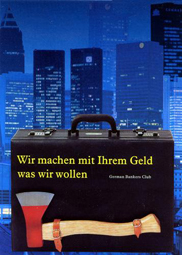 |
|
Klaus Staeck (D)
Klaus Staeck, who has been producing political photomontages in the tradition of the Dadaist John Heartfield since the early 1970s, shows typical posters. Counter drafts and answers to political slogans. Here as example: "Wir machen mit Ihrem Geld was wir wollen" ("We do what we want with your money") German Bankers Club.
|
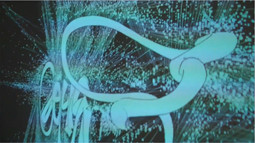 |
|
Evan Roth (Sydney)
Interactive - during the opening of the exhibition, the visitors are invited to leave their statements, which are regularly projected in a loop. The spectrum of his artistic activities ranges from net- and culture-critical, to media aesthetic and analytical works; to the development of typographic animated films, media art and political activism.
An interactive project is planned for the exhibition: Evan Roth & Chris Sugue have developed a software that transforms type into image or ornament. Visitors can write "their" slogans on a piece of paper on the computer and watch how these are transferred - with a time delay - into the visual world.
|
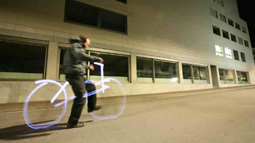 |
|
Lichtfaktor (D)
DThe group "Lichtfaktor", consisting of two members, show an installation in which they "draw with light into the night", as it is typical for their work. Currently, "Lichtfaktor" work often with advertising slogans - in the context of the exhibition, their work also represents, according to the theme of "slogans", an interface between advertising and politics. |
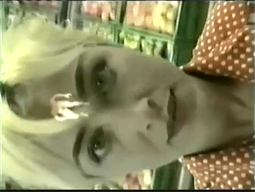 |
|
Pipilotti Rist (CH)
Subconscious influence. Pipilotti Rist shows her video work, which deals with everyday manipulation through advertising: A woman in a supermarket (the artist), partly superimposed and scaled down (levelling the individual and disturbing factors in the picture), suggests - to cheerful music - to the viewers that "something is always needed" and thus becomes, among other things, an opportunity for (self-) reflection. |
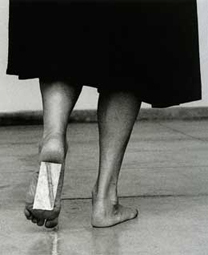 |
|
Helena Almeida (Lissabon, E)
In the background there are several groups responsible for slogans etc.
This photo reflects the hidden work. |
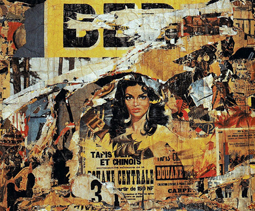 |
|
Jacques Villeglé (Quimper, F)
As an 'affichist' he created, like Raymond Hains, numerous décollages, i.e. montages of torn posters. He was strongly inspired by typography and mainly emphasized the aesthetic and colorful appeal of the structures and light-dark contrasts resulting from the décollage. |
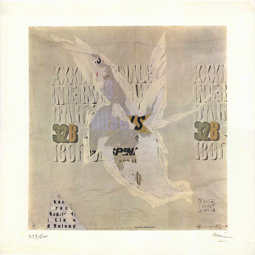 |
|
Raimond Hains (Saint-Brieuc, F)
I would present Hains, Villeglé and Dufrene together as a group of the Dé-coll/age technique. |
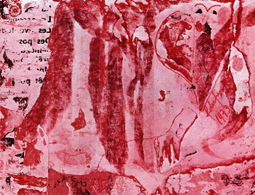 |
|
François Dufrêne (Paris, F)
Dufrêne's pictorial oeuvre consists of panel paintings in which he uses a Dé-coll/age technique to depict the backs of billboards, while colleagues such as Raymond Hains and Mimmo Rotella turned to the visible front. Like the other members of the group, Dufrêne used this technique to try to integrate the reality of everyday life into his art. |
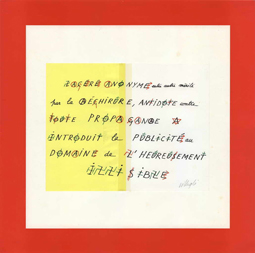 |
|
Jacques Villeglé (Quimper, F)
The works of the three artists, who work with the décollage technique, will be presented together in the exhibition. As an "Affichist", Villeglé, like Raimond Haines, created numerous décollages, i.e. montages of torn posters. He was strongly inspired by typography and emphasized mainly the aesthetic and color stimuli of the structures and chiaroscuro contrasts resulting from the décollage. Reminiscent of palimpsests, these works no longer allow a simple "reading" and reveal in a comprehensive sense the multi-layeredness and ambiguity of the context in which every apparently "unambiguous" linguistic utterance or pictorial representation oscillates. Dufrêne's pictorial work consists of panel paintings on which he uses the technique of decollage to depict the backs of billboards - in contrast to his colleague Raymond Haines, who turned his attention to the visible front sides. Like the other members of the group, Dufrêne uses this technique to attempt to integrate the complexity of reality or everyday life into his art. |
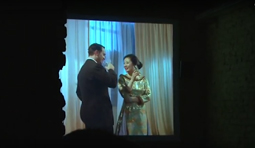 |
|
Anna Mitterer (A)
The video film "Tagline" (working title) aims to develop a narrative between two role models, female and male, based on a dialogue between the two. The special feature is that the dialogue consists of advertising slogans, female and male slogans are assigned to the two protagonists. However, in the confrontation, both the woman and the man try to counter the advertising slogans with a subjective-emotional response, but then themselves address the other again with a "tagline", a slogan, a mere empty phrase. Nevertheless, the dialogue results in a causal relationship in the sense of a conventional dramaturgy, so that the viewer may not immediately realize that both protagonists communicate almost exclusively in advertising slogans. |
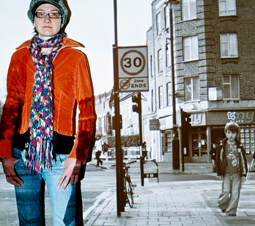 |
|
Christa Zauner (A)
Christa Zauner is showing a photographic work and an installation: The large-format analogue photo (1.80 cm x 1.80 cm) "Being Different" combines the enlarged, colourful portrait of an unknown person with a black and white city backdrop - a red carpet leading to the image, as a code for exclusivity, places the image in relation to the media practice of specifically presenting certain people (politicians, celebrities). By bringing an unknown person to the foreground, quasi "made famous", our habituation to the "exclusivity" of individuals is questioned, which at the same time always represents the exclusion of many. With the installation "Strand“ (Beach) Christa Zauner shows a beach cast in resin with rubbish, e.g. discarded packaging, and thus demonstrates that even rubbish (flotsam of our "civilization") still sustainably advertises products. |
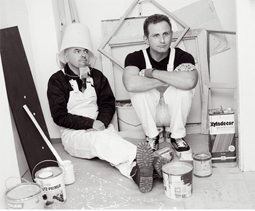 |
|
G.R.A.M. (A)
The artists' group G.R.A.M. are working on a new series and plan to show artificially represented settings, how parols and slogans affect the targeted audience. Using deliberately selected excerpts from the flood of media imagery, G.R.A.M. acts strategically and plays a subversive game with the perception of concepts. The perception of reality often becomes, as in real life, a new subjective reality. |
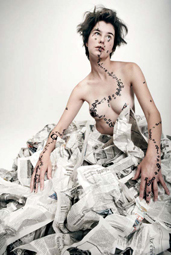 |
|
Nora Denes (H)
The Hungarian artist's photographic work shows a young, unclothed woman as a victim of the daily flood of information. She is covered up to her upper body in a pile of leafed-up daily newspapers. The printer-black writing of the newspapers runs across her arms, the upper body, up to her head. To correspond with this work, Nora Denes may also show a series of photographs that question the daily influence (" stultification"?) by the media. |













